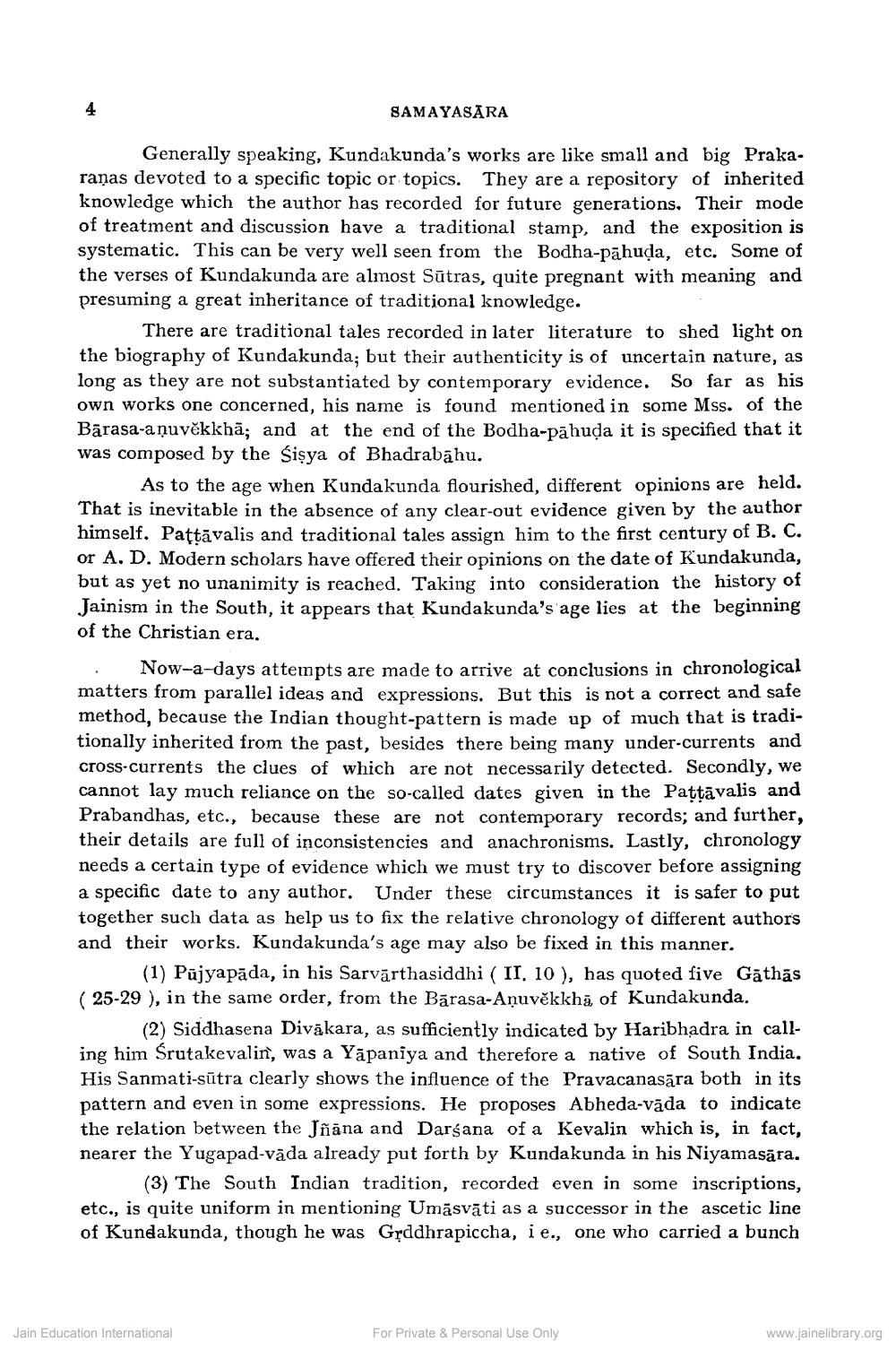Book Title: Samayasara Author(s): Kundkundacharya, Hiralal Jain, A N Upadhye Publisher: Bharatiya Gyanpith View full book textPage 7
________________ SAMAYASARA Generally speaking, Kundakunda's works are like small and big Prakaranas devoted to a specific topic or topics. They are a repository of inherited knowledge which the author has recorded for future generations. Their mode of treatment and discussion have a traditional stamp, and the exposition is systematic. This can be very well seen from the Bodha-pahuḍa, etc. Some of the verses of Kundakunda are almost Sūtras, quite pregnant with meaning and presuming a great inheritance of traditional knowledge. There are traditional tales recorded in later literature to shed light on the biography of Kundakunda; but their authenticity is of uncertain nature, as long as they are not substantiated by contemporary evidence. So far as his own works one concerned, his name is found mentioned in some Mss. of the Bārasa-aṇuvĕkkha; and at the end of the Bodha-pāhuḍa it is specified that it was composed by the Sisya of Bhadrabahu. As to the age when Kundakunda flourished, different opinions are held. That is inevitable in the absence of any clear-out evidence given by the author himself. Paṭṭāvalis and traditional tales assign him to the first century of B. C. or A. D. Modern scholars have offered their opinions on the date of Kundakunda, but as yet no unanimity is reached. Taking into consideration the history of Jainism in the South, it appears that Kundakunda's age lies at the beginning of the Christian era. Now-a-days attempts are made to arrive at conclusions in chronological matters from parallel ideas and expressions. But this is not a correct and safe method, because the Indian thought-pattern is made up of much that is traditionally inherited from the past, besides there being many under-currents and cross-currents the clues of which are not necessarily detected. Secondly, we cannot lay much reliance on the so-called dates given in the Paṭṭāvalis and Prabandhas, etc., because these are not contemporary records; and further, their details are full of inconsistencies and anachronisms. Lastly, chronology needs a certain type of evidence which we must try to discover before assigning a specific date to any author. Under these circumstances it is safer to put together such data as help us to fix the relative chronology of different authors and their works. Kundakunda's age may also be fixed in this manner. (1) Pūjyapāda, in his Sarvarthasiddhi ( II, 10), has quoted five Gāthās (25-29), in the same order, from the Barasa-Aņuvěkkha of Kundakunda. (2) Siddhasena Divākara, as sufficiently indicated by Haribhadra in calling him Śrutakevalin, was a Yapaniya and therefore a native of South India. His Sanmati-sutra clearly shows the influence of the Pravacanasara both in its pattern and even in some expressions. He proposes Abheda-vāda to indicate the relation between the Jñana and Dargana of a Kevalin which is, in fact, nearer the Yugapad-vāda already put forth by Kundakunda in his Niyamasāra. (3) The South Indian tradition, recorded even in some inscriptions, etc., is quite uniform in mentioning Umāsvāti as a successor in the ascetic line of Kundakunda, though he was Grddhrapiccha, i e., one who carried a bunch Jain Education International For Private & Personal Use Only www.jainelibrary.orgPage Navigation
1 ... 5 6 7 8 9 10 11 12 13 14 15 16 17 18 19 20 21 22 23 24 25 26 27 28 29 30 31 32 33 34 35 36 37 38 39 40 41 42 43 44 45 46 47 48 49 50 51 52 53 54 55 56 57 58 59 60 61 62 63 64 65 66 67 68 69 70 71 72 ... 370
